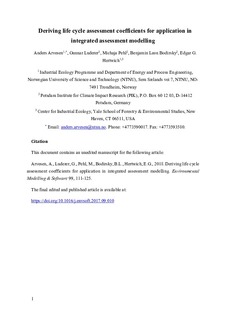| dc.contributor.author | Arvesen, Anders | |
| dc.contributor.author | Luderer, Gunnar | |
| dc.contributor.author | Pehl, Michaja | |
| dc.contributor.author | Bodirsky, Benjamin Leon | |
| dc.contributor.author | Hertwich, Edgar G. | |
| dc.date.accessioned | 2019-02-14T09:05:00Z | |
| dc.date.available | 2019-02-14T09:05:00Z | |
| dc.date.created | 2018-10-12T15:48:07Z | |
| dc.date.issued | 2018 | |
| dc.identifier.citation | Environmental Modelling & Software. 2018, 99 111-125. | nb_NO |
| dc.identifier.issn | 1364-8152 | |
| dc.identifier.uri | http://hdl.handle.net/11250/2585375 | |
| dc.description.abstract | The fields of life cycle assessment (LCA) and integrated assessment (IA) modelling today have similar interests in assessing macro-level transformation pathways with a broad view of environmental concerns. Prevailing IA models lack a life cycle perspective, while LCA has traditionally been static- and micro-oriented. We develop a general method for deriving coefficients from detailed, bottom-up LCA suitable for application in IA models, thus allowing IA analysts to explore the life cycle impacts of technology and scenario alternatives. The method decomposes LCA coefficients into life cycle phases and energy carrier use by industries, thus facilitating attribution of life cycle effects to appropriate years, and consistent and comprehensive use of IA model-specific scenario data when the LCA coefficients are applied in IA scenario modelling. We demonstrate the application of the method for global electricity supply to 2050 and provide numerical results (as supplementary material) for future use by IA analysts. | nb_NO |
| dc.language.iso | eng | nb_NO |
| dc.publisher | Elsevier | nb_NO |
| dc.rights | Attribution-NonCommercial-NoDerivatives 4.0 Internasjonal | * |
| dc.rights.uri | http://creativecommons.org/licenses/by-nc-nd/4.0/deed.no | * |
| dc.title | Deriving life cycle assessment coefficients for application in integrated assessment modelling | nb_NO |
| dc.title.alternative | Deriving life cycle assessment coefficients for application in integrated assessment modelling | nb_NO |
| dc.type | Journal article | nb_NO |
| dc.type | Peer reviewed | nb_NO |
| dc.description.version | acceptedVersion | nb_NO |
| dc.source.pagenumber | 111-125 | nb_NO |
| dc.source.volume | 99 | nb_NO |
| dc.source.journal | Environmental Modelling & Software | nb_NO |
| dc.identifier.doi | 10.1016/j.envsoft.2017.09.010 | |
| dc.identifier.cristin | 1620089 | |
| dc.relation.project | Norges forskningsråd: 209697 | nb_NO |
| dc.description.localcode | © 2017. This is the authors’ accepted and refereed manuscript to the article. Locked until 31.10.2019 due to copyright restrictions. This manuscript version is made available under the CC-BY-NC-ND 4.0 license http://creativecommons.org/licenses/by-nc-nd/4.0/ | nb_NO |
| cristin.unitcode | 194,64,25,0 | |
| cristin.unitname | Institutt for energi- og prosessteknikk | |
| cristin.ispublished | true | |
| cristin.fulltext | postprint | |
| cristin.qualitycode | 2 | |

